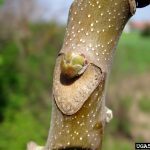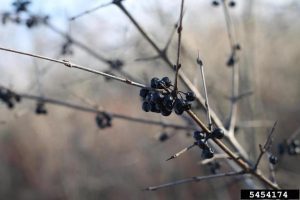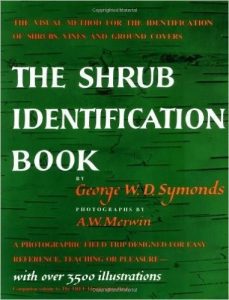Invasive trees and shrubs can be easy to identify during the growing season when you can look at their leaves and flowers. But, what happens in the winter when these plants have gone dormant and the leaves and flowers are long gone? Don’t give up, there are other ways of figuring out the identity of shrub species in winter. Plant bud and twig structure, bark characteristics, fruit, and the habitat plants are found in can all be used for successful identification.

Distinctive leaf scar can be seen on Tree of Heaven (Ailanthus altissima) photo credit: Jan Samenek, Bugwood.org
Becoming familiar with plant bud and twig structure will help to distinguish what is what in the field. Even without leaves, species have distinct physical characteristics that will reveal exactly what they are. When looking at a tree or shrub, look at their buds. Note their size, shape and color. Are there scales around it or is it a naked bud? Consider the bud arrangement; is it opposite or alternate? Leaf scars can also be distinctive.

Autumn Olive (Elaeagnus umbellata) with a distinctive thorn, and silver and copper color of twig. Photo Credit: Robert Videki, Doronicum kft., Bugwood.org
Twig structure is another characteristic that is very useful in winter identification. Note the size and color. Ask yourself how the branches are arranged; opposite or alternate (this will match the bud arrangement). The epidermis of the twig is often unique to a species. Is the bark smooth or perhaps furrowed? If you break off a piece of twig does it have an aromatic smell? Look at the cross section and observe the pith, is it hollow or solid? Are there thorns? If so, note their size and shape. These are some important questions to ask yourself when going through winter shrub identification. When you have some or all of these answers, you can more easily look up the final answer.

Common Buckthorn (Rhamnus cathartica) with characteristic terminal thorns and persistent fruit. Photo Credit: Rob Routledge, Sault College, Bugwood.org
Also look to see if there are any fruit that still hang from the shrub. Many of our invasive shrubs retain their berries well into the winter as they are generally of lesser nutritional value to our wildlife. If there are, note the type, color and arrangements of the fruits.
Just looking at a plant’s physical attributes may not be enough. Site characteristics help when identifying a plant. If a plant is known to grow on well-drained upland soils, chances are you will not find it growing in a wetland. Some plants can tolerate growing under heavy shade, while others only grow in an open field with plenty of light.
Finally, use your resources. There are many books and field guides that will be useful when trying to identify a plant. It is also helpful to understand how to use a dichotomous key. A dichotomous key is a process used for identifying species based on a series of choices between alternative characteristics. An example would be deciding between alternate or opposite patterns. This is called ‘keying-out’ a plant.
Identifying invasive shrubs in winter is not impossible, it just requires you refine your identification skills. With the mild winter we’ve been having, this is the perfect time to go for a hike and identify your trees and shrubs!
This blog post was written by Mathew Bilz, 2015 WNY PRISM Invasive Species Management Assistant


